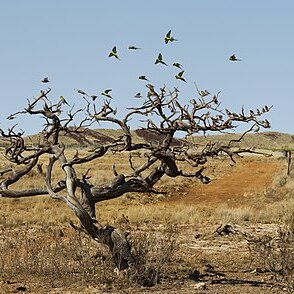Shrub or tree 3-7 m high, often gnarled, bushy, main branches often rather contorted and widely spreading. Branchlets glabrous or sparingly appressed-puberulous. Phyllodes ascending, elliptic or ligulate, tapering to acute or acuminate apex and long-attenuate base, straight to slightly curved, 5-12.5 cm long, 3.5-16 mm wide, rigid, ±glaucous, sericeous, glabrescent, with numerous very obscure closely parallel veins; central vein sometimes slightly raised. Inflorescences rudimentary 1-or 2-headed racemes with axes c. 0.2 mm long, often growing out; peduncles 7.5-15 mm long, ±appressed-puberulous; spikes 2.5-5.5 cm long, 5-7 mm diam., loosely flowered, light golden; receptacle appressed-hairy. Flowers mostly 5-merous; sepals 1/4-1/3 length of petals, united, often golden-puberulous. Pods pendent, linear, raised over and sometimes ±constricted between seeds, straight to slightly curved, 8-20 cm long, 7-18 mm wide, crustaceous-woody, irregularly coarsely reticulate, glabrous, shining. Seeds longitudinal, broadly elliptic, 6-10 mm long, peripherally crested, dull, brown; aril/funicle fleshy.
More
A spreading tree 4-6 m high and spreading 3-6 m wide. It is low, stunted and bent. The outer bark is fibrous and twisted. The branches are hairy at first but loose their hairs. The leaves (phyllodes) are 6-8 cm long by 0.5-1 cm wide. They are long and fatter at the centre tapering towards the ends. They stick outwards and have a sharp point. They are grey-green and flat. The veins are prominent. The flower heads are pale yellow and like rods. They are 1.5 cm long by 0.5 cm across. There is one flower in each angle where leaves join the stem. The pods are 6-11 cm long by 0.6 cm wide. They are straight and light brown.
Details of ecology, utilisation, etc. of A. xiphophylla are given in J.W. Turnbull (ed.), Multipurpose Australian Trees and Shrubs 214–215 (1986), B.R. Maslin et al., Wattles of the Pilbara (2010) and references therein.
More
The seeds are eaten. The gum is eaten. The gum can be stored.


